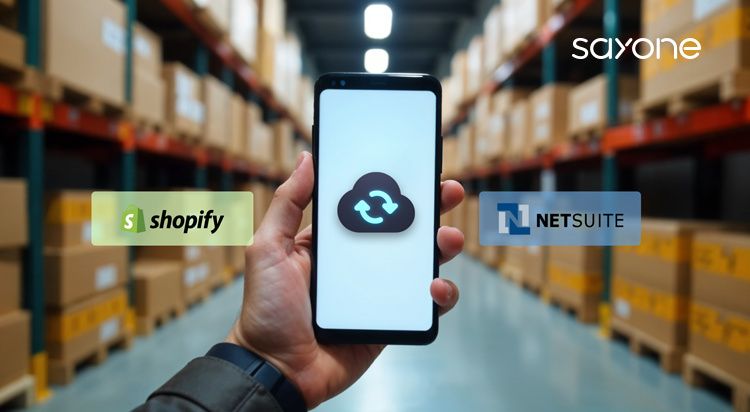
Subscribe to our Blog
We're committed to your privacy. SayOne uses the information you provide to us to contact you about our relevant content, products, and services. check out our privacy policy.

Renjith RajJuly 8, 20256 min read

Generating table of contents...
See how our client, a Shopify retailer with 10,000+ SKUs and 5 warehouses, partnered with SayOne to automate real-time inventory sync between Shopify and NetSuite - eliminating manual errors, reducing stock outs by 40%, and accelerating order fulfillment.
This is the success story of how we helped a growing Shopify retailer solve the constant headaches of overselling and stockouts. By building a real-time, automated bridge between their Shopify store and NetSuite system, we transformed their biggest operational bottleneck into a major strength. Inventory became virtually 100% accurate, manual data entry was eliminated, and order fulfillment times were slashed. The impact was felt across the board: warehouse staff worked faster, customer service dealt with fewer complaints, and shoppers enjoyed a reliable, frustration-free experience.
Ultimately, this automation gave the business the confidence and operational backbone to scale fearlessly. It’s a blueprint for any retailer looking to turn inventory management into a true competitive advantage.
During our deep-dive sessions with the client, it was clear that manual inventory management was crippling the client's growth. Their entire process relied on spreadsheets and manual data entry, creating a constant chain of delays and errors. Without real-time visibility, stock levels were frequently outdated, confusing sales, warehouse, and support teams. This slow, error-prone system simply couldn't keep pace with order volume, leaving them exposed to costly mistakes during their busiest periods.
When we reviewed our operations, the numbers told the story. Our order error rate was rising, and support tickets about duplicate orders and product confusion kept piling up. We were losing sales every month to stockouts, and our team was constantly playing catch-up with delayed purchase orders. Despite steady website traffic, we knew we were leaving money on the table. SayOne helped us realize the missing link was automation - and that insight changed everything.” - By Client
In our initial study, we closely evaluated various integration methods to fit the client’s order volume, workflow complexity, budget, and custom mapping needs. We compared no-code and low-code platforms like Pandaflow, Oracle NetSuite Connector, WebBee, and NetShopFlow for their ease of deployment and user-friendliness.
For more complex requirements, we considered iPaaS solutions such as Celigo and APPSeCONNECT, which offer advanced business logic and multi-entity sync. We also explored custom script-based options for maximum flexibility.
After weighing these options, we chose a tailored, bi-directional integration that eliminated manual touchpoints and reduced errors.

When a customer places an order on Shopify, the Shopify Admin API instantly creates a Sales Order and Customer record in NetSuite. Inventory levels sync continuously from NetSuite back to Shopify, while shipment and payment data flow back to Shopify upon fulfillment, creating a seamless, automated order-to-cash cycle that empowers the client’s teams and supports scalable growth.
We structured the integration project into clear phases, ensuring every detail was mapped and aligned with the client’s needs.
Our most crucial technical decision was building a true bi-directional, real-time sync using User Event Scripts and Admin APIs, making Shopify and NetSuite communicate seamlessly.
The success of this automation project is evident not just in the numbers but in the daily operations and morale of the client’s team. With fewer errors and faster processes, the business is now positioned to scale confidently, launch new products, and enter new markets, knowing their inventory and fulfillment systems can keep up..
Here’s a snapshot of the most significant improvements the client saw after implementing real-time sync between Shopify and NetSuite:

For any business planning a similar integration, start with a deep dive into your unique processes. Don’t just rush to implement off-the-shelf tools, as custom logic for data mapping and error handling is often the key to long-term success. Invest heavily in thorough testing and ongoing monitoring, because true automation isn’t a one-time setup - it’s a commitment to delivering measurable, reliable value every single day.” -by CTO
Automating inventory sync is just the first step for ambitious Shopify retailers. With real-time data flowing between Shopify and NetSuite, you unlock a world of automation possibilities that can streamline every aspect of your e-commerce operations.
Opportunities and Next Steps for Shopify Retailers:
Looking ahead, our vision is to help retailers go beyond inventory automation by integrating financial, shipping, and customer data into a unified, intelligent platform empowering you to run a truly connected, scalable, and data-driven business.
Investing in inventory automation for your Shopify store is a smart move that sets you up for long-term success. By connecting Shopify and NetSuite, you eliminate manual errors, speed up fulfillment, and gain real-time visibility across your operations.
This integration is more than just a technical upgrade; it's a foundation for confident growth, letting you scale your business and deliver a good customer experience. Every retailer’s needs are different, so it’s crucial to choose the right approach for your workflow.
Ready to future-proof your store? Connect with SayOne for a free consultation and start your automation journey today.

We're committed to your privacy. SayOne uses the information you provide to us to contact you about our relevant content, products, and services. check out our privacy policy.

About Author
Chief Technology Officer @ SayOne Technologies | Conversational AI, LLM

We collaborate with visionary leaders on projects that focus on quality